
Ormskirk is a market town in the West Lancashire district of Lancashire, England. It is located 13 miles (21 km) north of Liverpool, 11 miles (18 km) northwest of St Helens, 9 miles (14 km) southeast of Southport and 18 miles (29 km) southwest of Preston. Ormskirk is known for its gingerbread. In 2011 it had a population of 24,073.
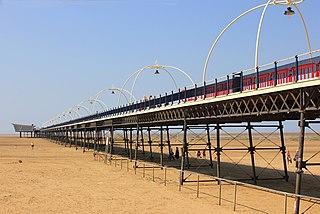
Southport is a seaside town in the Metropolitan Borough of Sefton in Merseyside, England. At the 2021 census, it had a population of 94,421, making it the eleventh most populous settlement in North West England.
The Landmark Trust is a British building conservation charity, founded in 1965 by Sir John and Lady Smith, that rescues buildings of historic interest or architectural merit and then makes them available for holiday rental. The Trust's headquarters is at Shottesbrooke in Berkshire.

Bretherton is a small village and civil parish in the Borough of Chorley, Lancashire, England, situated to the south west of Leyland and east of Tarleton. The population of the civil parish at the 2011 census was 669. Its name suggests pre-conquest origins and its early history was closely involved with the manor house Bank Hall and the families who lived there. Bretherton remained a rural community and today is largely residential with residents commuting to nearby towns.
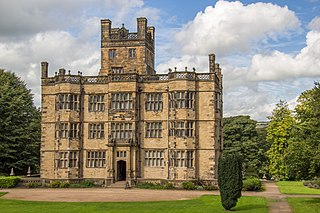
Gawthorpe Hall is an Elizabethan country house on the banks of the River Calder, in Ightenhill, a civil parish in the Borough of Burnley, Lancashire, England. Its estate extends into Padiham, with the Stockbridge Drive entrance situated there. The house is traditionally attributed to Robert Smythson. In the mid-19th century, the hall was rebuilt by Charles Barry, the architect of the Houses of Parliament. Since 1953 it has been designated a Grade I listed building. In 1970 the 4th Lord Shuttleworth gave the hall to the National Trust, with a 99-year lease to Lancashire County Council. Both bodies jointly administer the hall and in 2015 the council provided £500,000 funding for restoration work on the south and west sides of the house.
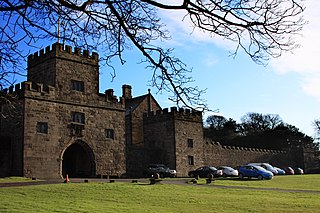
Hoghton Tower is a fortified manor house two-thirds of a mile (1 km) east of the village of Hoghton, Lancashire, England, and standing on a hilltop site on the highest point in the area. It takes its name from the de Hoghton family, its historical owners since at least the 12th century. The present house dates from about 1560–65.
North Meols is a civil parish and electoral ward in the West Lancashire district of Lancashire, England. The parish covers the village of Banks and the hamlet of Hundred End. The population of the parish/ward at the 2011 census was 4,146. Historically the parish covered a wider area including much of what is now Southport.
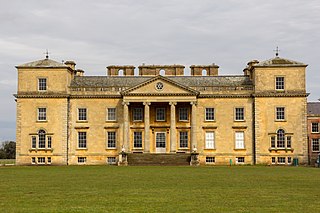
Croome Court is a mid-18th-century Neo-Palladian mansion surrounded by extensive landscaped parkland at Croome D'Abitot, near Upton-upon-Severn in south Worcestershire, England. The mansion and park were designed by Lancelot "Capability" Brown for the 6th Earl of Coventry, and they were Brown's first landscape design and first major architectural project. Some of the mansion's rooms were designed by Robert Adam. St Mary Magdalene's Church, Croome D'Abitot that sits within the grounds of the park is now owned and cared for by the Churches Conservation Trust.
Save Britain's Heritage is a British charity, created in 1975 by a group of journalists, historians, architects, and planners to campaign publicly for endangered historic buildings. It is also active on the broader issues of preservation policy. SAVE is a registered charity governed by a board of trustees.
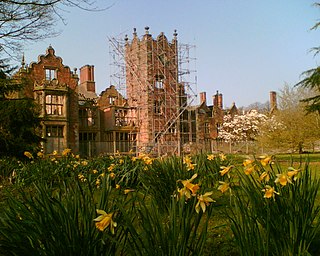
Bank Hall is a Jacobean mansion in Bretherton, Lancashire, England. It is a Grade II* listed building and is at the centre of a private estate, surrounded by parkland. The hall was built on the site of an older house in 1608 by the Banastres who were lords of the manor. The hall was extended during the 18th and 19th centuries. Extensions were built for George Anthony Legh Keck in 1832–1833, to the design of the architect George Webster.
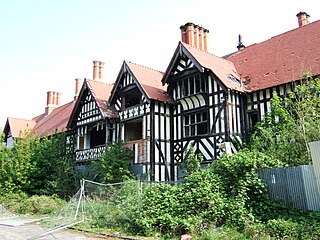
Greaves Hall was a country house on the outskirts of Banks in Lancashire, England, built in a Tudorbethan style for Thomas Talbot Leyland Scarisbrick in 1900.
Heritage Trust for the North West / Heritage Trust North West is a registered Building Preservation Trust, established in 1978 as a charity and company.

Carr House is a 17th-century house within the Bank Hall Estate, half-way between the villages of Tarleton and Much Hoole at the extreme north-west of the village of Bretherton, Lancashire, England. The building faces south to the Bretherton road, from which it stands back some distance, and has a foreyard inclosed on the west side by farm buildings.
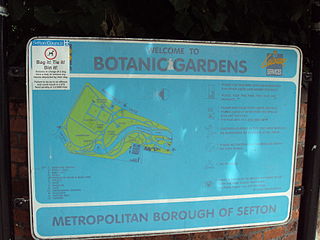
Southport Botanic Gardens is a botanical garden situated in the suburban village of Churchtown, Southport, in Merseyside, England. It is often called "The Jewel in the Crown" as it is nationally known for its floral displays, which have been featured in the BBC TV program Gardener's World.
Sir Harcourt Everard Clare was born in 1854, Market Bosworth, Leicestershire, England. He was well known in Lancashire where, in 1896, when he took up a post as Clerk at Lancashire County Council, which he kept until his death, at Bank Hall, in 1922.

Bank Hall Gardens comprise 18 acres (73,000 m2) of curtilage at Bank Hall, in Bretherton, Lancashire, England. The gardens contain specimen trees including a yew thought to be the oldest in Lancashire. Many architectural features, statues, low garden walls, conservatory and greenhouses have gone but there are plans to recreate them. The Bank Hall Action Group has tended the grounds since its formation in 1995. The group has planted specimen trees and identified the flora and fauna. The group opened the gardens to the public in 1999 after building a security fence, erecting scaffolding to secure the building and clearing the overgrowth. New varieties of snowdrops, some of which are unique to the gardens were uncovered. After a visit from the Snowdrop Society in 2007 the garden has become nationally known for snowdrop carpets during February.
The Bank Hall Estate is the demesne of the Jacobean mansion house of Bank Hall, including much of land around the village of Bretherton, which is owned by the Lilford Trust.

Scarisbrick Hall School is a mixed private school, located in Scarisbrick Hall, Lancashire, England, that educates children from nursery to age 18.

Cuerden Hall is a country mansion in the village of Cuerden near Preston, Lancashire, England. It is a Grade II* listed building. The Hall was formerly a family home between 1717 and 1906, and used by the Army until the 1960s. In 1985 it became a Sue Ryder neurological care centre. The Hall was sold to Manchester business man Colin Shenton in 2020 who is restoring it to its original purpose as a family home. The parkland and wider estate are known as Cuerden Valley Park. Cuerden Valley Park is now owned and managed by Cuerden Valley Park Trust which was a charity established in 1986, to ensure the longevity and management of the parkland itself. The Trust is made up for 650 acres of land; 1 reservoir, 15 ponds, 3 reed beds; over 5km of the river Lostock and 5 nature reserves.

Terraced Gardens of Rivington is a landscaped woodland on the hillside of Rivington Pike, in Rivington Parish in the Chorley Borough of Lancashire, England, originally designed as a Garden by T.H. Mawson and built as curtilage to a home of the soap magnate Viscount Leverhulme; as such, the area is not part of Lever Park. The gardens contains and abuts the SSSI of the West Pennine Moors. Today the former gardens are Grade II listed and contain eleven Grade II structures. The original design had three elements — the upper part being in the romanesque architectural style, the lower section, known as the Ravine, was a woodland with a man-made stream, and a Japanese-style garden, with a man-made pond constructed of Pulmonite which remains today. The gardens are leased to Rivington Heritage Trust by United Utilities and are undergoing restoration and preservation.














